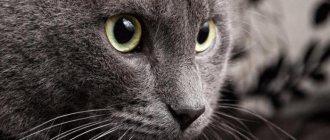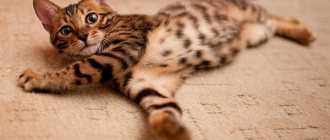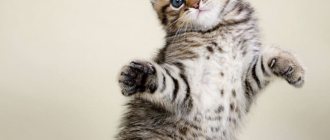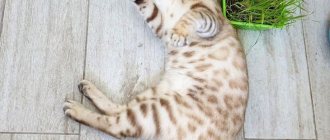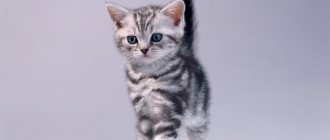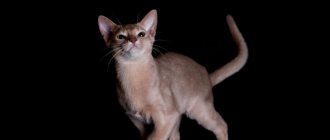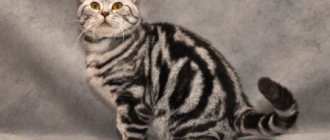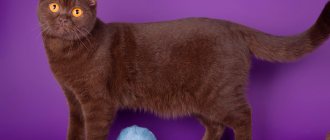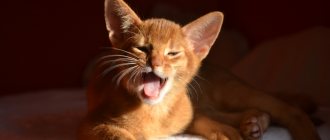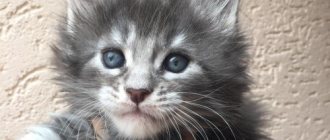Historical reference
The history of the appearance and first years of existence of the popular Russian Blue cat goes back more than a millennium and, probably, it is antiquity that explains many of the secrets and legends associated with representatives of this breed.
It is generally accepted that cats and cats of this breed gained fame from the ancient Slavs, thanks to which they were embodied in the famous image of Kota-Bayun . Among other things, green-eyed graceful creatures eventually became constant companions of almost the entire Russian royal family.
This is interesting! According to information that has survived to this day, Peter I and Catherine II, as well as Nicholas I and many other rulers of the Russian state, were seen among the owners of Russian blue cats.
There is also a version according to which breed representatives of the Russian Blue were brought to the territory of Western Europe by Arkhangelsk sailors, who highly valued such unpretentious animals as tireless rat catchers. According to reliable information, through the efforts of one of the famous English breeders, Russian blue cats first appeared in the Old World more than a century ago.
Currently, felinological organizations that have recognized the Russian Blue cat breed not only monitor the work of all nurseries and clubs, but also develop and actively improve breed standards, establishing requirements for organizing and holding exhibition shows.
During the Second World War, purebred animals almost completely disappeared, but were artificially recreated by breeders in Foggy Albion, after which the triumphant “return” of the Russian Blue to the territory of its historical homeland took place.
Return to content
History of the breed
The Russian Blue has many legends about the origin of the breed. However, researchers agree that its homeland is the Arkhangelsk region of Russia. The Russian Blue cat breed was especially dearly loved by two Russian monarchs - Peter I and Elizaveta Petrovna.
Russian blue cats felt great in palaces, receiving only respectful affection and delicious dinners. And Catherine II often gave foreign ambassadors amazing kittens with bluish fur, which seriously influenced the distribution and popularity of animals in the world.
The history of the Russian Blue cat in its usual form begins at the end of the 19th century, when a British breeder took several kittens from Arkhangelsk. Soon the breeders encountered a difficulty in breeding - there were too few animals for full selection.
Therefore, it was decided to cross them with cats of a similar color and Siamese (blue mask color). As a result, the Russian Blue cat practically lost its special features, its fur changed, and its character deteriorated.
The years of World War II were extremely difficult for the breed. During this period, the Russian blue cat was on the verge of extinction. However, in the post-war period, breeders began successful work on breeding Russian Blue cats. In 1949 the breed was registered with the Cat Fanciers Association.
Basic information about the next period speaks of the painstaking breeding of show-class Russian blue cats, which could be the breed standard.
The breed, practically destroyed in Russia, received a revival in the late eighties, when “Russian foreigners” were brought to the USSR. Breeders began to restore the Russian Blue by crossing it with local blue cats. Since 1991, the breed has received more than 20 national awards, and about 130 regional ones.
Behavior and temperament
Those wishing to purchase a pet of the Russian Blue cat breed should be prepared for the increased activity of such an animal, which is especially evident at the stage of adaptation to a new place. During the daytime, the kitten can sleep absolutely peacefully, but at night the peak of the pet’s main activity occurs, which, with the onset of darkness, begins to play or jump, and also make all sorts of sounds.
From a very early age, the Russian Blue pet is distinguished by some characteristic features, represented by:
- good mental abilities;
- high level of devotion;
- activity and playfulness;
- cheerful disposition;
- cleanliness.
As a rule, all Russian Blue cats are pronounced conservatives . Therefore, they get used to certain conditions of detention, and are able to very acutely experience changes in their environment.
This is interesting! Representatives of the Russian Blue breed are distinguished by a very calm character, as well as a balanced temperament, due to which they are among the most popular cats not only in our country, but also among foreign breeders.
Among other things, thanks to their innate cleanliness, kittens of this breed get accustomed to the litter box quite quickly and without problems, which undoubtedly greatly facilitates the process of socialization of a pet.
Return to content
Appearance of a Russian Blue cat
There are several main breed characteristics of the Russian Blue, which include a uniform blue coat with a silver tint, a harmoniously built and graceful body with long slender limbs.
This is interesting! Characteristics that are preferable in accordance with one standard may be completely undesirable according to another standardization, therefore, most often, attention is paid to cumulative breed standards, taking into account the special specifics of various types.
The presence of a straight profile with clear vibrissae pads, creating the illusion of a smile, as well as emerald almond-shaped eyes.
Body
The Russian Blue breed is characterized by a lean, muscular, strong and well-formed body . The standard physique is represented by an elongated, lightweight body, with not too heavy bones and moderately well-developed muscles. The limbs are quite long, thin and light, with rounded paws. The tail is straight, tapering smoothly to a thin tip.
Head
The head region is short, with a V-shaped muzzle and a profile reminiscent of the head of a cobra.
The profile is quite clearly defined, of medium width, and with a slight deflection in the upper bow. Plump and clearly defined whisker pads give the pet a slight smile.
Eyes
An adult Russian Blue cat has emerald green, almond-shaped or round eyes. Kittens of this breed are born with soft blue eyes, but at about two months their color begins to change, so they first become dirty brown-yellow, and then the standard green color.
Ears
The breed is characterized by fairly large ears with pointed tips, distinguished by thin, almost transparent skin. The ears should be set vertically in British-type animals, and wide-set in American-type animals. There is practically no hair on the inside of the ears. A purebred animal has ears whose width at the base is slightly less than their height.
Wool
The coat of the Russian Blue pet has a very attractive and well-groomed appearance. The animal is not only clean, but also has smooth, soft fur. A pedigree pet's coat should have a fairly dense texture and fit snugly to the body.
The coat is of equal length throughout the body, and the thick undercoat forms a protective layer that retains heat well. The coloring of the undercoat must be in a tone similar to the overall color of the coat.
Colors
The coat color that distinguishes the Russian Blue cat always has a characteristic blue color. Only the shade range can change. The color of the coat can vary from light shades to dark blue, almost black.
A clear standard regulating the coat color of the Russian Blue has not currently been established. In many ways, the shade and color of the coat directly depend on the genetic characteristics of the kitten’s parents, and are inherited by the animals.
Return to content
Standard blue color
If the kitten is not genetically ticked, then there will be a pattern on the fur | moire. The residual pattern disappears from the coat by 4-5 months; a striped pattern in the form of rings may remain on the tail of blue cats.
Photo of British Blue Shorthair cat
The coat color allowed by experts should be in shades from light blue to gray-blue, but if the cat is dark gray | “wet asphalt” shade is considered a significant drawback; breeders try to work with light shades of blue.
Wool requirements:
- Soft, dense, slightly behind the body;
- Light color;
- Even coloring of hair pigment along the entire length to the roots;
- Spots, tabby patterns, silver tipping are prohibited;
- The undercoat should be dyed in the main tone; brown, cream, white colors are not welcome.
Eyes:
- bright gold;
- copper;
- orange.
The nose, like the pads on the paws, are black and blue.
Disqualifying Faults
There may be several reasons for the disqualification of a Russian Blue cat . Firstly, animals with kinked or defective tails are disqualified. The presence of medallions or any white spots on the coat would be unacceptable for a purebred pet.
This is interesting! In accordance with modern European standards, Russian Blues with round or yellowish eyes and a square head area are subject to disqualification. According to American standards, serious deficiencies include underbite and a weak jaw.
When choosing a kitten, you need to remember that the breed standards established by the English association of breeders GCSF do not differ significantly from the basic standards in felinological international federations, including FIFе and WСF, but have obvious differences with the generally accepted parameters in the American associations CFA and TICA.
Return to content
